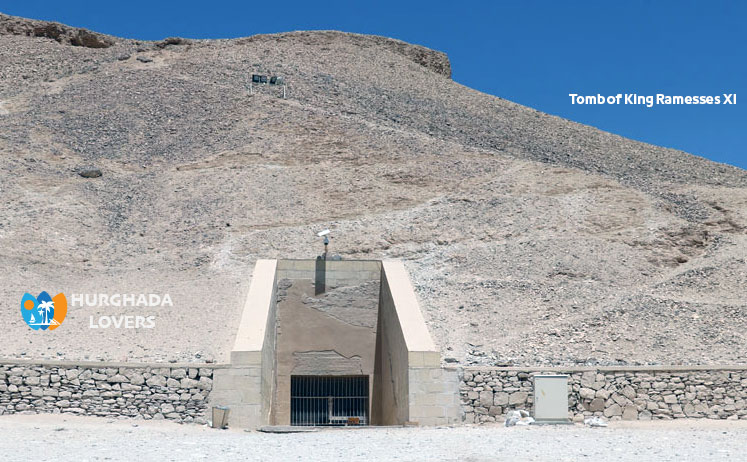Tomb of King Ramesses XI | KV4 in Valley of the Kings, Luxor, Egypt – Egyptian Tombs
Facts and history of the construction of Egyptian Pharaonic tombs in the Ancient Egypt civilization and more Tomb design, visiting hours, ticket and entry prices and more about the Ancient Egypt History.
It is one of the tombs that were discovered in the Valley of the Kings area in Egypt, and King Ramesses XI is the last king of the Twentieth Egyptian Dynasty in the period of The New Kingdom of Egypt, known as The Ramesside Period.
After his death, Egypt entered the third era of decline “Third Intermediate Period of Egypt” and chaos and revolutions began to spread “Revolutions in Ancient Egypt” and the thieves of the Pharaonic tombs “Ancient Egyptian Grave Robbers“.
He is considered one of the most famous of the Egyptian Pharaohs kings who ruled Egypt, as Ramses ruled Egypt between 1107 and 1077 BC, and he is one of the members of the Twentieth Dynasty of Egypt.
Tomb of King Ramesses XI Facts
The tomb of Ramses XI is 104.09 meters long and was discovered since ancient times to indicate the development of Sculpture in Ancient Egypt and Architecture in ancient Egypt.
It was rediscovered by the English Egyptology and Egyptologist John Lewis Romer in 1978 and 1980 AD..
The coffin “Ancient Egyptian Coffins” of King Ramses XI has not been found.
The tomb is known as the Tomb of King Ramses XI and was originally built as a shelter for Ramses XI..
Ramesses XI was the last king of the 20th Dynasty..
But the work was not finished when King Ramses XI died, and he was not even buried there..
When King Ramses died, it was the beginning of the renaissance of the priests of Thebes city.
Pinedjem I of the Twenty-first Egyptian Dynasty, the High Priest of Amun at the Temple of God Amun, the most famous of the ancient Egyptian deities – Ancient Egyptian gods and Goddesses in the beliefs and Ancient Egyptian religion, in Thebes, set out to rob the tomb so that he could be buried there..
Pharaonic Egyptian Cartouche were found in the tomb indicating this purpose of the priest..
The priest then gave up on the idea, and he was not buried with it either..
Historical facts
The reason for the fame of the tomb of King Ramses XI is that it was the last tomb to be built in the Valley of the Kings..
In addition to the previous reason, there is also another reason, which is the use of the cemetery as a residence for workers who were destroying the city..
Where the priests of Amun ordered some workers to spread corruption and chaos and destroy the first city and the funerary temples located near the area..
So the workers took the cemetery as their residence, and those events were during the third decade of decline that Egypt went through..
In addition to the previous reasons, it is famous because it is considered one of the first cemeteries that were opened to the public for them to visit..
The cemetery was also used as a residence for Copts during the early Coptic period and Byzantine eras..
About Ramses XI
Ramses XI died in 1069 BC in the Sa El-Hagar “Sais”, Delta region, as in the Geography of ancient Egypt.
While the date of birth dates back to the 12th century BC..
Ramesses XI married Tentamun and had Nodjmet, Duat, Hathor, and also Tentamun..
The father of Ramses XI is King Ramesses X.
Egypt was not in the best condition during his reign, but rather suffered from instability, both economically and politically, as Agriculture in Ancient Egypt, Industry in ancient Egypt, Ancient Egyptian science, Ancient Egyptian Literature, and Medicine in ancient Egypt deteriorated..
Note: Facts and secrets of the history will be added soon…
Hurghada Excursions Lovers, Best Travel Agency in Hurghada to provide daily tours to visit the Tourist attractions of Luxor by Hurghada to Luxor Tours and Hurghada to Pyramids Trips. Book online when you come to Hurghada, El Gouna, Sahl Hashish, Makadi Bay, Soma Bay, Egypt Tours Packages.
